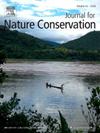Optimum water level for the ex situ and in situ conservation of endangered Korean aquatic plant Cicuta virosa L.
IF 2.2
3区 环境科学与生态学
Q2 BIODIVERSITY CONSERVATION
引用次数: 0
Abstract
Most endangered species are in a critical state of survival, and natural recovery in their native habitats is unlikely. Determining the optimum water level that affects the growth and survival of aquatic plants is crucial for their restoration. In the present study, we investigated the effects of different water levels on the growth of Korean endangered aquatic plant Cicuta virosa L. in two experimental environments: a greenhouse and a reservoir. The water level was adjusted to three conditions (−15 cm, 0 cm, and 15 cm) and 1- and 2-year-old plants were used. The plant height, root collar diameter, rhizome volume, and growth and survival rates were measured. In the greenhouse experiment, for 1-year-old plants, the best growth rate was observed at water levels of −15 ∼ 0 cm, but for 2-year-old plants, good growth rate was observed at water levels of 0 cm. The growth of rhizome volume was not affected by water level. In the on-site experiment at the reservoir, the different growth rates was not showed according to the water level, but the survival rate was good at −15 cm water level. However, the low survival rate (50 %) of C. virosa L. within the natural habitat remains a limitation of this study, and a strategy to increase survival rates when they are exposed to various natural threats is necessary.
韩国濒危水生植物毒蝉迁地和原地保护的最佳水位。
大多数濒危物种都处于生存的危急状态,在它们的原生栖息地自然恢复是不可能的。确定影响水生植物生长和生存的最佳水位对水生植物的恢复至关重要。本研究在温室和水库两种实验环境下,研究了不同水位对韩国濒危水生植物毒蝉(Cicuta virus L.)生长的影响。水位调整为- 15 cm, 0 cm和15 cm三种条件,使用1岁和2岁的植物。测定株高、根颈直径、根茎体积、生长成活率。在温室试验中,1年生植株在- 15 ~ 0 cm的水位下生长速度最快,2年生植株在0 cm的水位下生长速度最快。根茎体积的生长不受水位的影响。在水库现场试验中,不同的水位没有表现出不同的生长速度,但在- 15 cm的水位存活率都很好。然而,本研究的局限性在于其在自然栖息地的存活率较低(50%),因此有必要制定提高其在各种自然威胁下存活率的策略。
本文章由计算机程序翻译,如有差异,请以英文原文为准。
求助全文
约1分钟内获得全文
求助全文
来源期刊

Journal for Nature Conservation
环境科学-生态学
CiteScore
3.70
自引率
5.00%
发文量
151
审稿时长
7.9 weeks
期刊介绍:
The Journal for Nature Conservation addresses concepts, methods and techniques for nature conservation. This international and interdisciplinary journal encourages collaboration between scientists and practitioners, including the integration of biodiversity issues with social and economic concepts. Therefore, conceptual, technical and methodological papers, as well as reviews, research papers, and short communications are welcomed from a wide range of disciplines, including theoretical ecology, landscape ecology, restoration ecology, ecological modelling, and others, provided that there is a clear connection and immediate relevance to nature conservation.
Manuscripts without any immediate conservation context, such as inventories, distribution modelling, genetic studies, animal behaviour, plant physiology, will not be considered for this journal; though such data may be useful for conservationists and managers in the future, this is outside of the current scope of the journal.
 求助内容:
求助内容: 应助结果提醒方式:
应助结果提醒方式:


